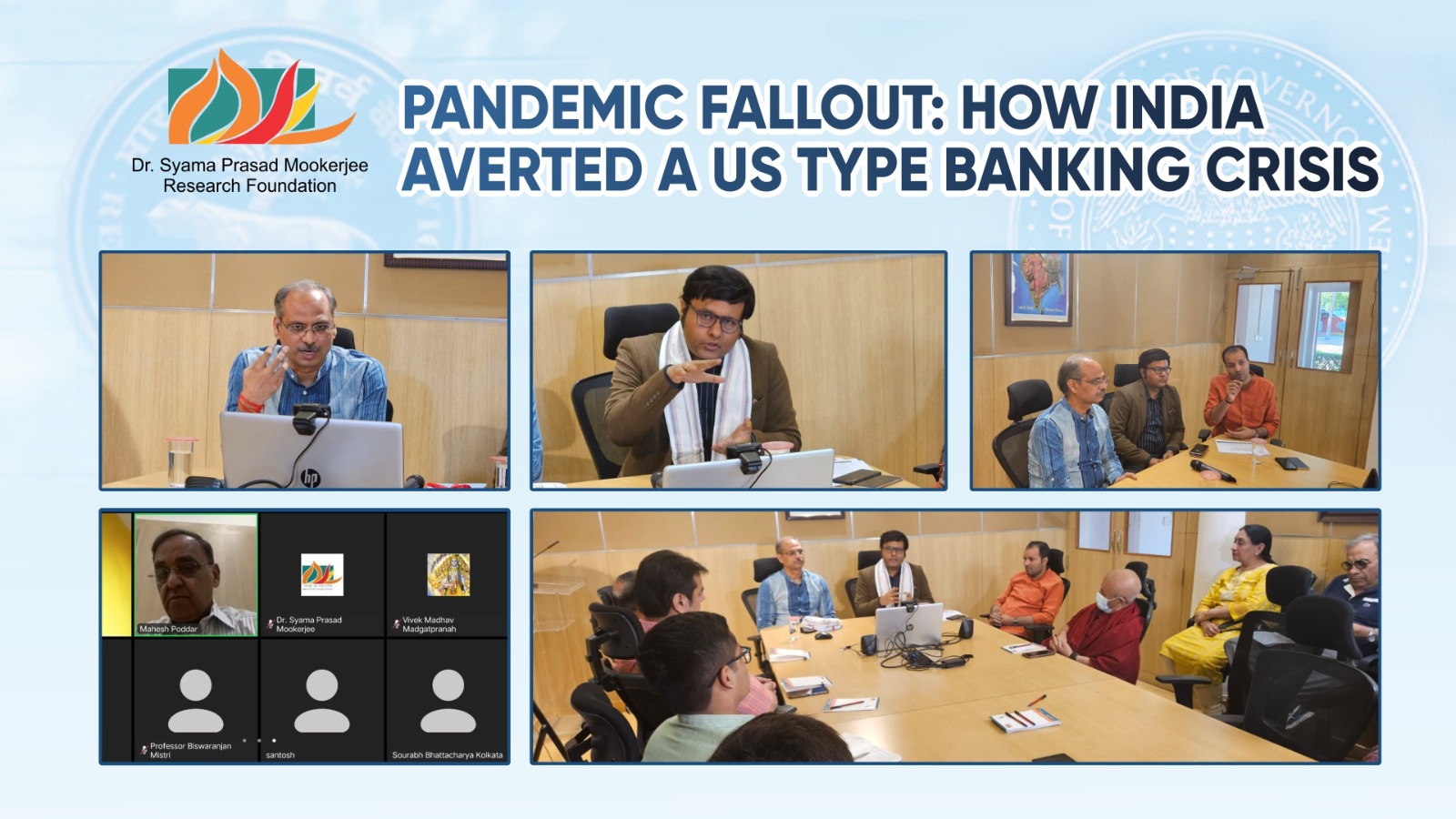Speakers: Harshvardhan Tripathi (Senior Journalist & Columnist) and Pathikrit Payne (Senior Research Fellow, SPMRF)
- Syama Prasad Mookerjee Research Foundation (SPMRF) organized a discussion titled ‘Pandemic Fallout: How India Averted a US Type Banking Crisis’ on 8th April 2023 at 4:30 PM. The speakers were Policy Analyst Shri Pathikrit Payne and renowned Journalist and Columnist Shri Harshvardhan Tripathi, both Senior Research Fellows at SPMRF.
- The Welcome Address was delivered by Shri Shiwanand Dwivedi, Senior Research Fellow, SPMRF. He introduced the guests to the listeners and gave a brief intro of the topic under discussion by highlighting the fact that Government of India has undertaken a host of reforms related to banking and infrastructure during and even after the Covid pandemic. At a time when the entire global banking system has seen fluctuations, including that of the USA, India has moved ahead with its concept of ‘Atmanirbhar Bharat’, which has aroused the jealousy of many people who have tried to create false narratives and made every possible attempt to pull the country down, but their efforts were unsuccessful.
- The first speaker, Shri Pathikrit Payne began his discussion by highlighting that when the pandemic came, a narrative was created that Indian economy will collapse. But India not only fought Covid but also its source, i.e., China. It focused on economic growth as well as military infrastructure, because of which, by 2022, India had emerged as the 5th largest economy. On the other hand, major banks in USA are on the brink of facing an economic crisis similar to that of the Lehmann Brothers Bankruptcy way back in 2008. The inflation in USA is at an all-time high. Reason is that during Covid, USA distributed an amount of 5 trillion dollars, 3 trillion of those were given to private companies. Initially it looked good, and the US economy fared well but soon, inflation started increasing and its impact was felt across the entire US economic system. The Federal Reserve (equivalent to India’s RBI) started increasing interest rates with the hope that people shall deposit money in the banks. Initially the interest rate stood at 1.5-1.7% but in the last 1.5 years, the rate has gone up to 4.75 to 5 % percent. When the money is deposited, it becomes liability for the banking system because they need to return it with interest. When interest rate increases, lending rate also increases. Increase in lending rate coupled with high inflation created a systematic challenge which has already started in the USA. Hence, the value of dollar is declining and countries are slowly moving away from dollar,
- On the question of why this happened in USA and why not in India, Shri Pathikrit Payne pointed out that India during Covid took care of basic food and health by providing food ration and free vaccine, rather than circulating or distributing printed money, as had been done by the USA. Interestingly, many opposition leaders in India too were pressing upon the government to follow suit. India went for ‘Resilience Created Reform’ rather than distributing currency. India’s industrial proficiency helped us in manufacturing more vaccines. We also brought oil from Russia at discounted rates by defying US sanctions. The concept of Atmanirbhar Bharat has led to our defence sector becoming self-sufficient and have also made our MSME’s strong and our economy resilient. and hence, they are suffering a ‘Banking Crisis.’
- The second speaker, Shri Harshvardhan Tripathi spoke about the crisis faced by the Silicon Valley bank of USA. This bank had invested 80 million dollars in mortgage-backed securities with the hope of increased returns but due to the Covid fallout and the distribution of money to private companies, mortgage-backed securities investment started declining to the point of absolute nil, hence the condition of the startups in USA have been worsening. In the absence of any concrete regulatory mechanisms, USA could not handle this crisis efficiently and failed to avert it.
- Shri Harshvarhan Tripathi also mentioned that India’s banking sector was in bad shape when Narendra Modi govt took over in 2014. More than Rs. 3 lakh crores have been pumped in various banks by the Modi govt since 2014. From this year itself, RBI brought changes due to which health of banking system improved and the government banks benefitted due to these measures. In 2015, measures like Asset Quality Review of all the Non-Profitable Assets, Insolvency Bankruptcy Code etc. were undertaken by the Modi govt. As a result, the net profit of India’s government banks increased immensely. Also, during Covid times, MSME’s were given Credit Guarantee Scheme, so MSME sector revived. The government provided a relief package worth Rs. 20 lakh crores to boost the economic system. More than 80000 crore assets belonging to the fugitive Vijay Mallya have been recovered. These banking reforms have gone a long way in strengthening our banking institutions and as a result, India’s banking system emerged out of the Pandemic in flying colours.
- The economic and health crisis which had engulfed the entire world in the wake of the Covid pandemic, has been managed exceptionally well by India. Given our enormous population, if not for the Modi government’s efforts, the consequences would have been disastrous. We need to credit the Modi government for ensuring that the Indian economy and the banking system remains strong as compared to other countries.
- The discussion was followed by a brief interactive session involving the attendees and the speakers for around 15 minutes.
- The programme ended with a vote of thanks by Shri Shiwanand Dwivedi.
(The views expressed are the author's own and do not necessarily reflect the position of the organisation)

